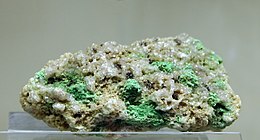| Caledonite | |
|---|---|
 Caledonite (green) on cerussite | |
| General | |
| Category | Sulfate minerals |
| Formula (repeating unit) | Cu2Pb5(OH)6CO3(SO4)3 |
| IMA symbol | Cdo[1] |
| Strunz classification | 7.BC.50 |
| Crystal system | Orthorhombic |
| Crystal class | Pyramidal (mm2) (same H-M symbol) |
| Space group | Pmn21 |
| Unit cell | a = 20.089(7) Å, b = 7.146(3) Å, c = 6.56 Å; Z = 2 |
| Identification | |
| Color | Blue; green |
| Crystal habit | Typically striated prismatic or tabular crystals; radial aggregates |
| Cleavage | [001] perfect; [100] distinct |
| Fracture | Uneven |
| Tenacity | Brittle |
| Mohs scale hardness | 2.5–3 |
| Luster | Vitreous |
| Streak | Green-white; blue-green |
| Diaphaneity | Transparent to translucent |
| Specific gravity | 5.6–5.8 |
| Optical properties | Biaxial (−) |
| Refractive index | nα = 1.818(3) nβ = 1.866(3) nγ = 1.909(3) |
| Birefringence | δ = 0.091 |
| Pleochroism | Weak |
| 2V angle | Measured: 85° |
| References | [2][3][4][5] |
Caledonite, whose name derives from Caledonia, the historical name of its place of discovery (Scotland), is a richly colored blue-green sulfate-carbonate mineral of lead and copper with an orthorhombic crystal structure. It is an uncommon mineral found in the oxidized zones of copper-lead deposits.
- ^ Warr, L.N. (2021). "IMA–CNMNC approved mineral symbols". Mineralogical Magazine. 85 (3): 291–320. Bibcode:2021MinM...85..291W. doi:10.1180/mgm.2021.43. S2CID 235729616.
- ^ Mineralienatlas
- ^ "Handbook of Mineralogy" (PDF). Archived from the original (PDF) on 2016-03-03. Retrieved 2016-12-20.
- ^ MinDat Listing
- ^ Webmineral Listing